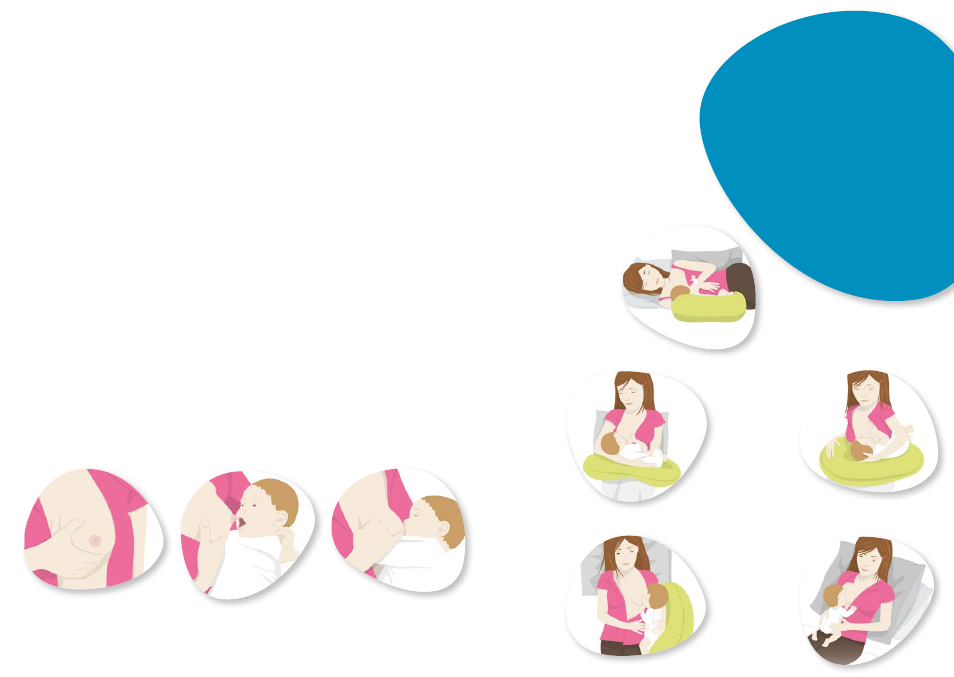Breastfeeding: what changes, How to breastfeed, What positions are best for breatsfeeding – Bebe Confort Breastfeeding User Manual
Page 3: When to start, How to stimulate, Breastfeeding, Milk supply, Lying, Breastfeeding position

4
5
Breastfeeding:
what changes?
During your pregnancy, your breasts are slowly preparing for breastfeeding: the size increases at the same
time as the size of your nipples, under the effect of hormones secreted by the ovary and the placen-
ta. Towards the end of your pregnancy and after delivery, two hormones will activate milk production:
prolactin and oxytocin will be released as soon as baby will start to be breastfed. The amount of milk
produced depends on the number of times baby eats.
The ejection reflex is simultaneous in both breasts: while your baby eats on one side, milk flows from the
other.
Don’t worry, there are no ideal breast shape to breastfeed. Breasts don’t store milk but produce it while
baby eats. So big or small breasts make no difference, baby will always have enough to eat!
When to start
breastfeeding?
It is preferable to start breastfeeding your baby as soon as possible after the birth. First of all, your baby will
take advantage of the colostrum (rich milk) only produced when lactation starts. Also, the first time your
baby will be breastfed will favor breastfeeding.
How
to breastfeed?
Breastfeeding is very natural but not always intuitive and can be a difficult process to start. Here are some
tools to naturally overcome the ups and downs of breastfeeding.
How to stimulate
milk supply?
Use your senses:
looking, listening and smelling your baby will trigger milk ejection. Make sure to be comfor-
tably installed before starting to breastfeed your baby: back and arms on cushions and feet can be raised if
you want. Now it’s time to enjoy this precious moment! If milk ejection is difficult, try to massage your breast
before breastfeeding.
Place your fingers flat under your
breast, it looks like your hand is shaped
like the letter C
Position your nipple towards the
baby’s mouth. Once it’s wide open
and the tongue is flat, you can start
breastfeeding
When your baby is not eating anymore
and is chewing on your nipple, remove
your baby from your breast by making
sure to place your little finger between
your baby’s gums to interrupt suction
without hurting your nipples.
1•
Hand shaped like
the letter C
2•
Place your baby near
your breast
3• Remove baby from
your breast
What positions
are best for
breatsfeeding?
It is recommended to change breastfeeding posi-
tions in order to:
•
Stimulate every area of the breast
•
Prevent nipple pain because the pressure is made
on different areas
Your baby can be positioned comfortably on a cushion,
chin must touch your breast and ears, shoulders and
hips must be straight lined. If you are well installed, baby
must not pressure your nipple and you shouldn’t even
need to support your baby.
Breastfeeding
is going well when:
Baby’s chin pushed into the breast.
• A big part of the areola is covered by the baby’s mouth
and lips
• Baby’s inferior lip is folded towards the exterior
• Baby’s tongue is positioned under the nipple
• A movement can be seen near the forehead and
ears when baby starts sucking and swallowing
• Baby’s feeding is made at his own pace: he
sucks for a few seconds, stops to swallow
and then starts the whole process again
• You can hear your baby swal-
lowing the milk
Baby is facing you,
head in your arms and
body lying down on a
breastfeeding cushion
supporting his weight.
To be comfortably sitting,
you can place a pillow
behind your back which
must always be straight and
relaxed. Don’t lean on your
baby.
Baby is supported by a
breastfeeding cushion
and positioned un-
der your arm on the
desired breast side.
Baby is lying down
on the side, his body
facing yours.
Baby is lying down next to
you on a cushion. You
must be able to support
your baby’s back with
your arm.
Semi-reclined posi-
tion and baby is lying
on your stomach.
Perfect position if
breastfeeding is pain-
ful or if baby has a hard
time grabbing your
breasts.
Your baby and you are lying on the side
facing each other with pillows protec-
ting both your and baby’s back and your
head. Baby’s head is placed on your arm
or on the bed. This position allows you to
relax and stay in bed while breastfeeding.
Lying
on the side
Cradle hold
breastfeeding
position
«Rugby ball»
breastfeeding
position
Biological nurturing
breastfeeding position
Laid-back
(after a c-section)
breastfeeding position
